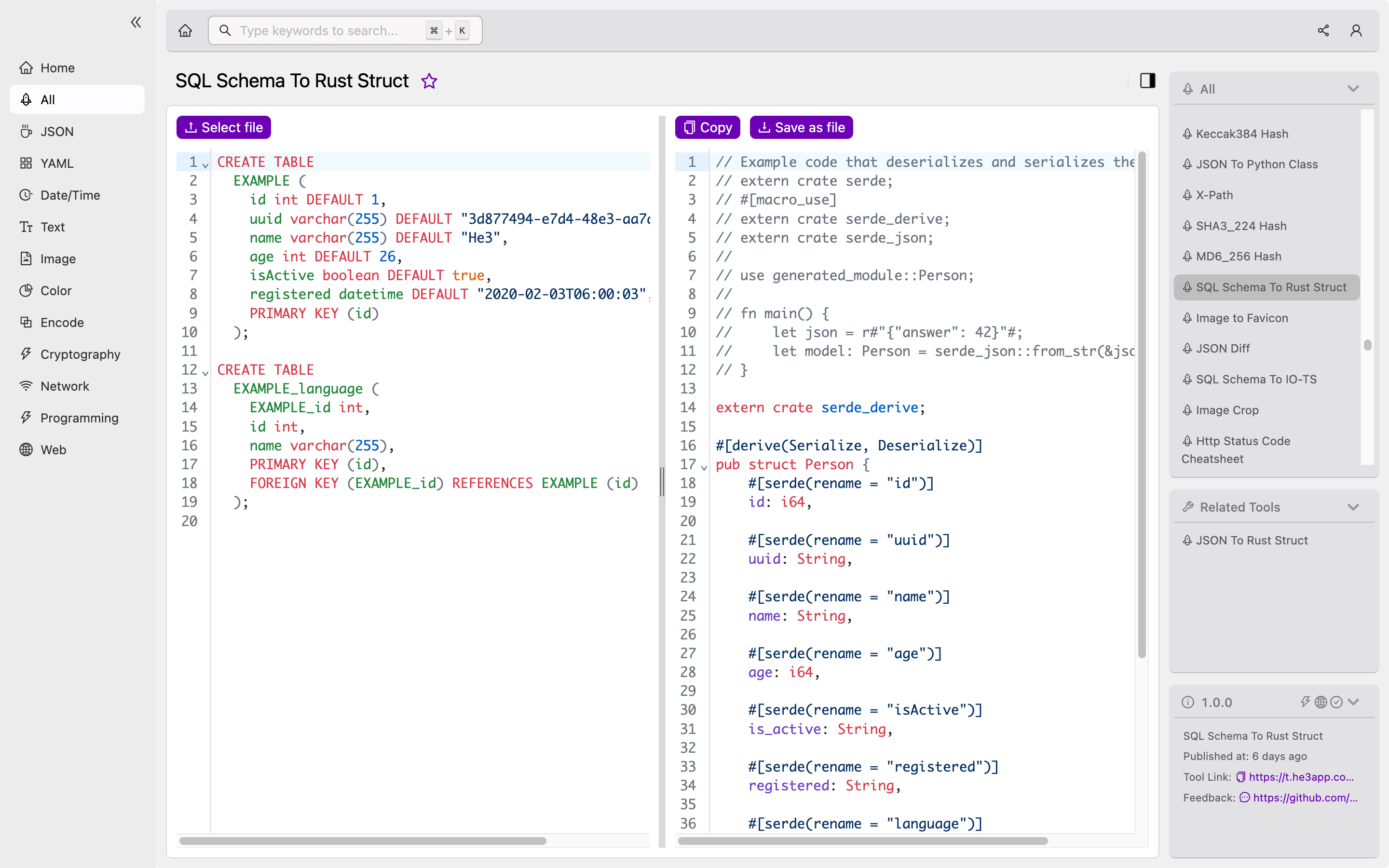Introduction
In the world of programming, it is important to understand different languages and how to translate between them. SQL is a standard language for managing relational databases, while Rust is a fast and safe systems programming language. Converting SQL Schema to Rust Struct is a crucial step when building applications that require interaction with databases. This article will explore the concept of SQL Schema to Rust Struct and how it works.
Concept and How it works
SQL Schema is a blueprint for a database that defines the structure of the data. Rust Struct, on the other hand, is a user-defined data type that groups data fields into a single entity. The conversion process involves mapping the fields in a SQL table to the corresponding fields in a Rust Struct. The resulting Rust Struct can then be used to manipulate data from SQL tables using Rust programming language.
Sample Code
Here is an example of converting a SQL Schema to Rust Struct using He3 Toolbox:
// Import necessary modules
use he3::toolkit::sql_schema_to_ruststruct;
// Define SQL Schema
const SQL_SCHEMA: &str = "CREATE TABLE users (
id INT PRIMARY KEY,
first_name TEXT NOT NULL,
last_name TEXT NOT NULL,
email TEXT NOT NULL UNIQUE,
age INT NOT NULL
);";
// Convert SQL Schema to Rust Struct
let rust_struct = sql_schema_to_ruststruct(SQL_SCHEMA);
// Print Rust Struct
println!("{:#?}", rust_struct);Scenarios for Developers
SQL Schema to Rust Struct conversion is essential for developers creating database-driven applications. It enables them to efficiently manipulate data using Rust programming language. Developers can use this conversion method to create Rust Structs for each table in their database, making it easier to query and update data.
Key Features
Some key features of SQL Schema to Rust Struct conversion include:
- Efficient mapping of fields from SQL table to Rust Struct fields
- Automated conversion using He3 Toolbox
- Resulting Rust Struct can be used to manipulate data from SQL tables using Rust programming language.
Misconceptions and FAQs
One common misconception is that SQL Schema to Rust Struct conversion requires extensive knowledge of both SQL and Rust. However, tools like He3 Toolbox make the conversion process simple and efficient. Here are some FAQs:
Q1. Can I use SQL Schema to Rust Struct conversion for any database? A1. Yes, SQL Schema to Rust Struct conversion can be used for any database that supports SQL.
Q2. Is it necessary to use Rust programming language to manipulate data from SQL tables? A2. No, it is not necessary to use Rust programming language. However, Rust’s speed and safety make it a popular choice for database-driven applications.
How to Use SQL Schema To Rust Struct
Developers can use the SQL Schema to Rust Struct tool in He3 Toolbox easily. Or, they can manually map fields from SQL tables to Rust Struct fields, though it is time-consuming and error-prone. To use He3 Toolbox, simply navigate to the “SQL Schema To Rust Struct” tab, paste your SQL Schema in the input field, and click “Convert”. The resulting Rust Struct will be displayed, which can then be copied and pasted into your Rust code.

Conclusion
Converting SQL Schema to Rust Struct is a crucial step when building applications that interact with databases. It enables developers to efficiently manipulate data using Rust programming language. Tools like He3 Toolbox make the conversion process simple and efficient, eliminating the need for extensive knowledge of both SQL and Rust. For more information on SQL and Rust, check out the following links:
